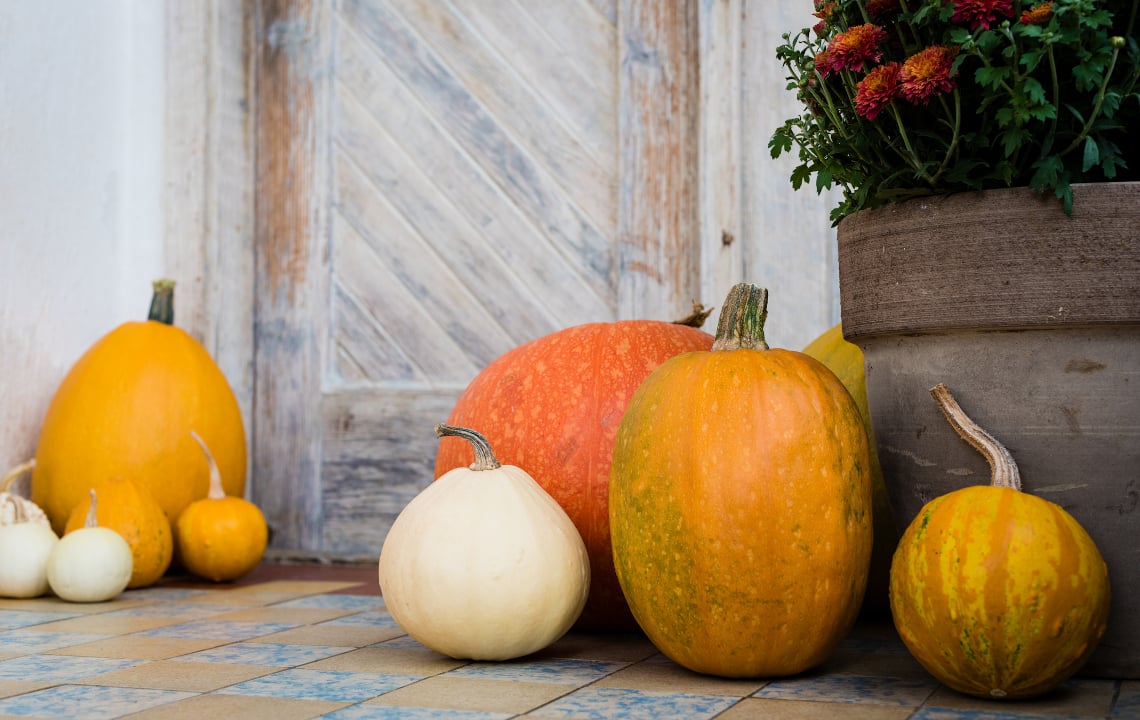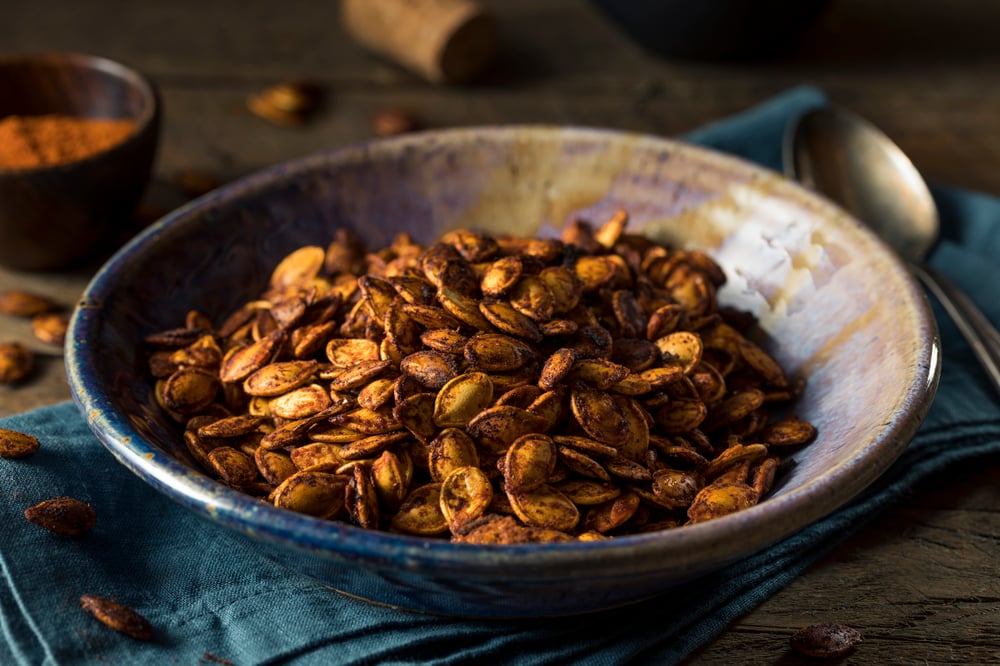As soon as fall arrives, so do the ornamental (and edible) pumpkins. Rethink:Rural writer, Mara Watts, shares a few ideas for minimizing waste and maximizing your eco-friendly pumpkin decor.
Real pumpkins can be used in various ways to decorate your home and yard.
For a touch of fall indoors, line a fireplace mantel with greenery and tiny pumpkins. Or, gather the family to carve pumpkins for a ghostly spectacle on the front porch. The options are limitless when you add a natural element to your home decor.
But after the season is over and it’s time to purge the pumpkins, what do you do with them all?
Surely, nature’s favorite orange gourd can serve a purpose well beyond its ability to beautify its surroundings.
I’m here to tell you, yes, yes it can. That gorgeous pile of multi-colored gourds can be sustainably dealt with long after their use as decor. From making delicious fall edibles to composting, pumpkins of all sorts can be sustainably disposed of, resulting in zero waste.
Before we jump in, let's touch on the importance of sustainable, eco-friendly decorating
Eco-friendly homes have increased in popularity over the past decade with the use of solar panels, reduction in plastic use and shopping locally.
As the world becomes more environmentally conscious, sustainable eco-friendly decorating is now a growing trend.
But what is sustainable decorating?
Sustainable or eco-friendly decorating is a form of decorating with natural elements — such as non-plastic and organic products — that benefit, rather than harm, the environment.
Lucky for you, that includes pumpkins!
Here are a few tips to help you decorate with pumpkins in a sustainable and eco-friendly way
Make a decorating plan ahead of time.
Before purchasing any pumpkins, decide on how you plan to use them in your decor.
Draw pictures, make lists and tally up the exact number you need before heading out to shop. This will eliminate overspending on too many “what-if I need more” pumpkins and keep you hyper-focused on what you really need.
Decide on how you’ll use the pumpkins after the season is over.
In this article, you'll learn a few ideas on how to reduce unnecessary pumpkin waste.
Before the season is over, make a plan for either feeding the edible pumpkins to animals, composting or preserving parts of the pumpkin. This will help you plan ahead of time, making it easier to dispose of the pumpkins sustainably.
Buy from local pumpkin patches and farmers.
Instead of running out to the big box stores, consider supporting your local farmers.
Often, local farmers grow heirloom pumpkin varieties, those that are unique and vary in color, adding a touch of pizzazz to your decor.
Spend a day with the family at a local pumpkin patch and purchase directly from your farmer.
Place Decorative pumpkins Strategically To Avoid Damage.
Damaged pumpkins rot much faster, making them less edible or usable later.
Be mindful of where pumpkins are sitting, and avoid areas where large machinery is used, or where children may be running and playing.
Avoid painting or using candles on or in your pumpkins.
If you plan to feed decorative pumpkins to the animals, or compost them later, avoid paints and candlewax as these can be toxic.
Appreciate the pumpkin’s natural beauty and decorate without the use of paints, markers or candles.
5 Zero-Waste Eco-Friendly Ideas for Your Pumpkin Decor
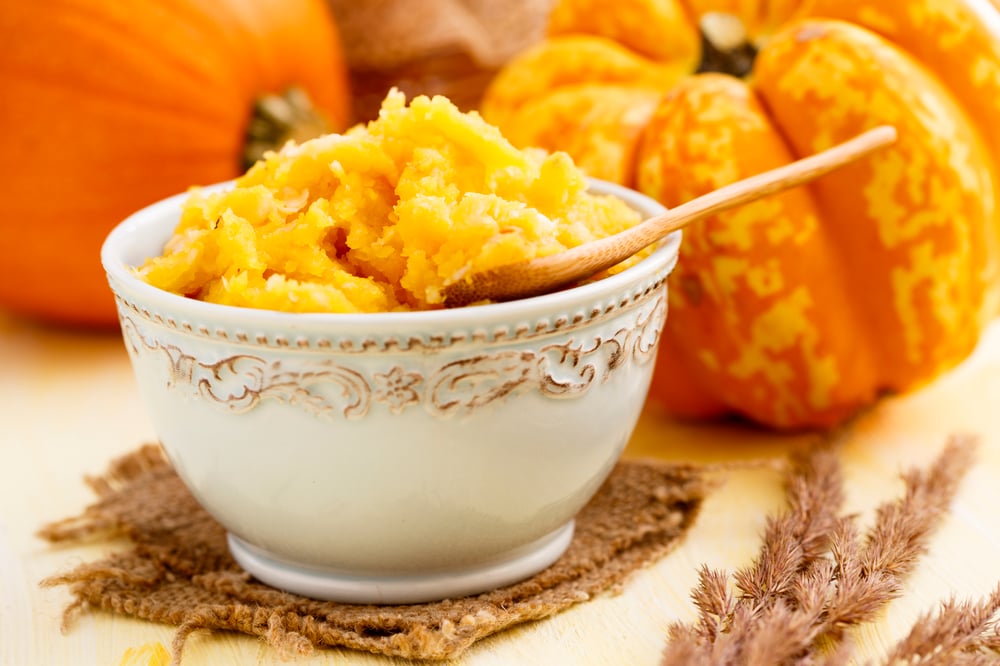
#1: Preserve Parts of the Pumpkin
When you’re ready to toss your pumpkins, consider cutting them open and preserving various parts for later use. Below are a few ideas to help you save as much of the pumpkin as possible.
Dry and Save Pumpkin Seeds
Saving seeds from various fruits and vegetables is a rewarding activity. Seeds can be stored for a lengthened amount of time and used for future gardening. If you’d like to grow a pumpkin patch, drying and saving seeds from decorative pumpkins is a great idea.
To save your pumpkin seeds, rinse and lay them on a dry paper towel. Allow them to fully dry for about one week. Once the seeds are dry, store them in an envelope or a mason jar with a tight lid.
Freeze the Raw Pumpkin Flesh
Pumpkin flesh is the inside of the pumpkin that is attached to the outer skin. It can be cut out into small squares.
Store the small squares in a ziploc bag in the freezer. Pumpkin flesh can be used in many different ways, such as:
- Boiling with other vegetables to make a vegetable broth
- To make pumpkin hummus
- In hearty soups or curries
Make and Freeze Pumpkin Puree
Although canned pumpkin puree can be purchased at your local grocery store, you just can’t beat the homemade stuff. From scratch, pumpkin puree can be stored in the refrigerator for up to a week and for several months in the freezer.
Pumpkin puree is simple to make. Simply scoop the pumpkin flesh from the pumpkin, removing the seeds. Throw the flesh into a food processor and blend until creamy and smooth. Spoon the puree into a ziploc bag for freezing or a mason jar for keeping in the refrigerator.
Unfortunately, home-canning pumpkin is no longer recommended by food safety experts. This is due to the inability of home canning equipment to raise the temperature of the thick puree enough to be safely stored.
#2: Whip Up Some Delicious Pumpkin Goodies
If you plan on carving pumpkins, be sure to set the pumpkin fruit and seeds aside.
From pumpkin muffins to homemade pumpkin spice latte mix, the possibilities in the kitchen are endless - and delicious!
Bake Pumpkin Muffins
This is one of my mother-in-law’s signature fall recipes. After discovering my daughter’s egg allergy, she quickly dug into her recipe files to find an egg-free breakfast option: pumpkin muffins.
Packed with the nutrients and vitamins from the pumpkin, and the sweetness of the brown sugar, I’m always overjoyed to share this fall treat.
The following recipe yields about 10-12 small pumpkin muffins.
Ingredients:
- 2 cups of all-purpose flour
- 1 tsp baking powder
- ½ tsp baking soda
- ¼ tsp salt
- 1 tsp cinnamon
- ½ tsp pumpkin pie spice
- ¼ tsp nutmeg
- 1 cup pureed pumpkin
- ⅔ cup milk
- ½ cup brown sugar
- ¼ cup olive oil
- ½ tsp vanilla extract
Procedure:
- Preheat the oven to 350 degrees. Line a muffin tin with muffin liners, or spray with a non-stick spray.
- Stir together all dry ingredients. When mixed well, add the wet ingredients to the dry ingredients. Stir well until combined.
- Fill the muffin tin with the mixture and bake for about 20 minutes, or until a toothpick comes clean when inserted into the middle of the muffins.
- Once baked, remove from the oven and allow the muffins to cool for at least 5 minutes. Remove from the tin and enjoy!
Make Pumpkin Spice Latte Mix
As soon as the first leaf turns from green to an autumnal color, coffee companies pull out their pumpkin spice latte mix, ready for the craze.
But many pumpkin spice latte mixes contain quite a bit of sugar and artificial ingredients.
To avoid this, try making your own homemade pumpkin spice latte mix.
This recipe from Ambitious Kitchen is absolutely delicious.
Make a large batch of the last four ingredients, not including the whipped cream, to store in the fridge for later use.
Roast the Pumpkin Seeds
Seasoned and roasted pumpkin seeds are a quick and easy way to make a crunchy and healthy snack for the family.
Here’s how:
- After removing the seeds from the pumpkin, wash and dry them. You want to make sure you get all of the ooey gooey pumpkin pulp off of the seeds. Allow the seeds to fully dry on a clean towel.
- Next, season the seeds with your favorite seasoning. I’m a big fan of tossing them in a bowl of olive oil, salt, pepper and a dash of garlic powder. However, you can use any seasoning you like.
- Spread the seasoned seeds on a non-stick cookie sheet. Roast the seeds in the oven at 350 degrees for up to 15 minutes or until they are golden brown.
Lastly, enjoy! Roasted pumpkin seeds are highly nutritious and can be used in various recipes, on salads or take as an on-the-go snack.
Make Healthy Pumpkin Protein Bars (and other creative ideas)
Rethink:Rural’s editor, Kristen Boye, shared various pumpkin recipes in the article: 7 Creative Ways to Use Pumpkin (besides pie and cheesecake), including:
- Healthy Homemade Protein Bars
- Pumpkin Seed Pesto
- Pickled Pumpkin
- How to Preserve Your Own Pumpkin Puree
- Mini-Pumpkin Trifles
- Savory Pumpkin Biscuits or Scones
- A Pasta Dish with Pumpkin, Brown Butter, Sage, and Fettuccine (yum!)
#3: Make a Pumpkin Face Mask
As the cool autumn weather begins to set in, so does dry, dull skin.
Pumpkin is used widely in spa and facial products due to its rich vitamin, enzyme and antioxidant content. A, C, and E are among the many vitamins that provide your skin with a natural and healthy glow.
So why not try making a pumpkin face mask with the extra pumpkin lying around?
My favorite mask is this one from FOREO. Not only does this recipe include pumpkin, but it also mixes in an egg, some honey and apple cider vinegar.
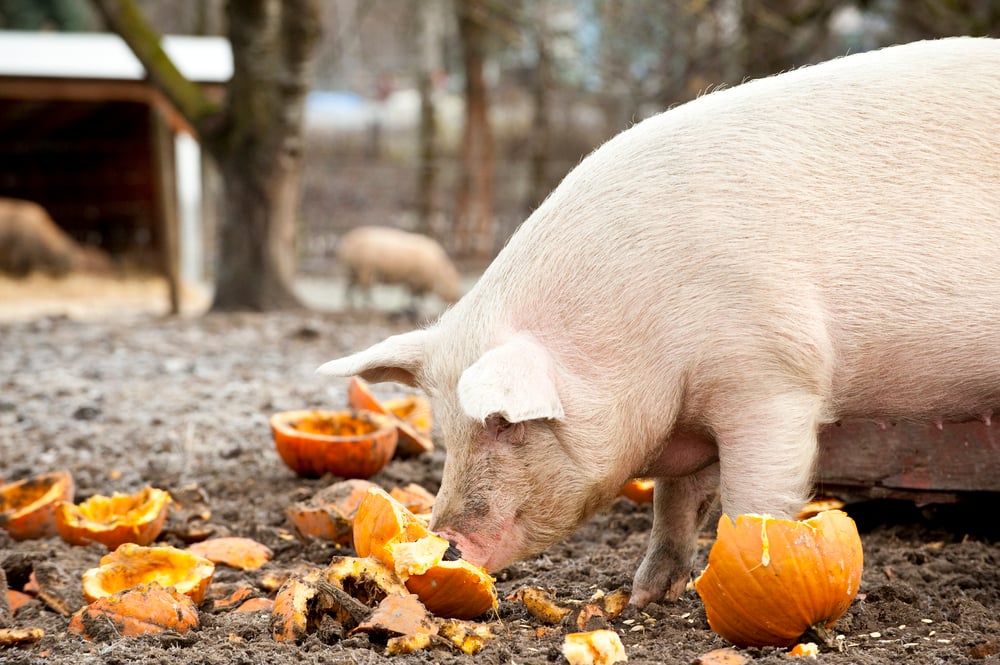
#4: Feed Pumpkins to Livestock & Wildlife
When feeding pumpkins to animals, the rule of thumb is to only feed the truly edible pumpkin varieties. If you would not personally consume the pumpkin, do not feed it to your livestock or local wildlife.
According to this Extension report written by Karla H. Jenkins at the Panhandle Research and Extension Center at the University of Nebraska-Lincoln, “pumpkins make a good supplemental protein and energy source for cattle.” She also states that “pumpkins can make a good supplemental feed for dry pregnant cows in the fall.”
This report from the Texas Farm Bureau states that most, if not all, livestock on a small hobby farm can benefit from eating pumpkins. In addition to cattle, livestock such as pigs, chickens, horses and even goats, enjoy munching on the flesh and seeds of edible gourds.
If they are not rotting, painted or covered in candlewax, pumpkins provide livestock with highly digestible fiber, vitamins and minerals. It is recommended that pumpkins be smashed or opened up before feeding them to any animal.
In addition to its nutritional value, pumpkin seeds have been known to many farmers as a natural livestock dewormer.
Pumpkin seeds contain an amino acid and natural deworming compound known as cucurbitacin. Cucurbitacin is a substance that, when ingested, paralyzes any present worms. The paralyzed worms are then passed by the animal, aiding in combating parasitic infection.
Notably, pumpkins are a great supplemental food for animals on the farm.
As with any new food, introduce pumpkins slowly into your livestock’s diet. This helps to ensure that your animals do not have any gastrointestinal issues or allergies associated with the new food.
Also, consider feeding your pumpkins to local wildlife.
Smash or break open used pumpkins and throw them into the woods, or out into a field. Deer, squirrels, bears and raccoons will feast on the pumpkin which provides vitamins and minerals to nourish their bodies.
As stated above, avoid feeding painted, rotten or spoiled pumpkins to local wildlife, as this can be toxic to their systems. The best advice is to cut the rotting portion off of the pumpkin and throw the rest into your compost pile.
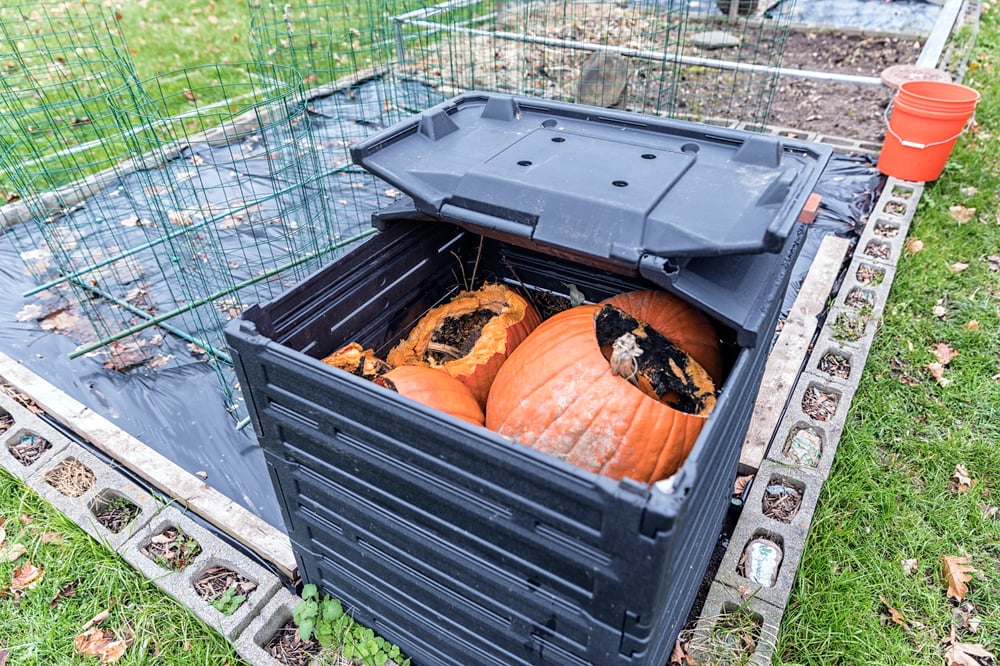
#5: Compost the Pumpkins
One of the best ways to dispose of any used pumpkins is to toss them into a compost pile.
Composting is a means of decomposing organic products, such as plants, food and even animal manure, to later mix into the garden. Compost increases the health of garden soil and is beneficial to crops grown.
To compost used decorative pumpkins, be sure all pumpkins are free from paint or other toxic coatings. Remove all seeds, as these are non-compostable. And cut the pumpkin into small pieces to increase the rate of decomposition.
The Fork in the Road adds an optional step: leave the pumpkin pieces outside for a few days before adding them to the pile.
Interestingly, the article shares that local wildlife will eat the pumpkin pieces, which will contribute to the decomposition process.
Pumpkins are an excellent addition to the compost pile, because of their high nitrogen content. This provides a lot of nutrients to the garden in the upcoming months.
That's the Scoop on Zero Waste Eco-Friendly Pumpkin Decor
Decorating with pumpkins this fall certainly adds a seasonal and stylish element to your home.
Make an entryway natural and eco-friendly. Include pumpkins on a tabletop centerpiece to introduce a touch of texture and color. Pile a few large gourds in a wheelbarrow surrounded by planters of mums or other seasonal foliage. The possibilities are truly endless.
When it’s all said and done — or the carved pumpkins start to cave and look, well, a bit scary — you’ll have several options for reducing waste and getting the most out of your natural decor.
Happy Fall, Y’all!


